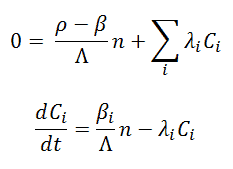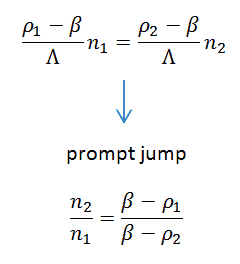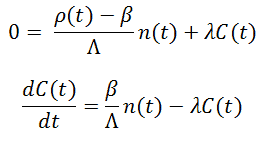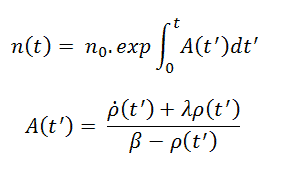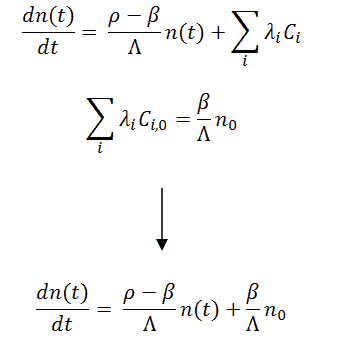Sometimes, it is convenient to predict the behavior of a reactor qualitatively. The exact solution can be obtained relatively easily using computers. Especially for illustration, the following approximations are discussed in the following sections:
- Prompt Jump Approximation
- Prompt Jump Approximation with One Group of Delayed Neutrons
- Constant Delayed Neutron Source Approximation
Suppose we are interested in long-term behavior (asymptotic period) and not interested in the details of the prompt jump. In that case, we can simplify the point kinetics equations by assuming that the prompt jump takes place instantaneously in response to any reactivity change. This approximation is known as the Prompt Jump Approximation (PJA). Due to prompt neutrons, the rapid power change is neglected, corresponding to taking dn/dt |0 = 0 in the point kinetics equations. That means the point kinetics equations are as follows:
From the equation for neutron flux and the assumption that the delayed neutron precursor population does not respond instantaneously to a change in reactivity (i.e., Ci,1 = Ci,2), it can be derived that the ratio of the neutron population just after and before the reactivity change is equal to:
The prompt-jump approximation is usually valid for smaller reactivity insertion, for example, for ρ < 0.5β. It is usually used with another simplification and the one delayed precursor group approximation.
This simplification then leads to:
Assuming that the reactivity is constant and n1/n0 can be determined from the prompt jump formula, this equation leads to a very simple formula:
Suppose we are interested in short-term behavior and not interested in the details of the asymptotic behavior. In that case, we can simplify the point kinetics equations by assuming that the production of the delayed neutrons is constant and equal to the production at the beginning of the transient. This approximation is known as the Constant Delayed Neutron Source Approximation (CDS), in which changes in the amount of delayed neutrons are neglected, corresponding to taking dCi(t)/dt = 0 and Ci(t) = Ci,0 in the point kinetics equations. That means the point kinetics equations are as follows:
The above equation can be solved analytically, and assuming that the reactivity is constant, the solution is given as:
- J. R. Lamarsh, Introduction to Nuclear Reactor Theory, 2nd ed., Addison-Wesley, Reading, MA (1983).
- J. R. Lamarsh, A. J. Baratta, Introduction to Nuclear Engineering, 3d ed., Prentice-Hall, 2001, ISBN: 0-201-82498-1.
- W. M. Stacey, Nuclear Reactor Physics, John Wiley & Sons, 2001, ISBN: 0- 471-39127-1.
- Glasstone, Sesonske. Nuclear Reactor Engineering: Reactor Systems Engineering, Springer; 4th edition, 1994, ISBN: 978-0412985317
- W.S.C. Williams. Nuclear and Particle Physics. Clarendon Press; 1 edition, 1991, ISBN: 978-0198520467
- G.R.Keepin. Physics of Nuclear Kinetics. Addison-Wesley Pub. Co; 1st edition, 1965
- Robert Reed Burn, Introduction to Nuclear Reactor Operation, 1988.
- U.S. Department of Energy, Nuclear Physics and Reactor Theory. DOE Fundamentals Handbook, Volume 1 and 2. January 1993.
Advanced Reactor Physics:
- K. O. Ott, W. A. Bezella, Introductory Nuclear Reactor Statics, American Nuclear Society, Revised edition (1989), 1989, ISBN: 0-894-48033-2.
- K. O. Ott, R. J. Neuhold, Introductory Nuclear Reactor Dynamics, American Nuclear Society, 1985, ISBN: 0-894-48029-4.
- D. L. Hetrick, Dynamics of Nuclear Reactors, American Nuclear Society, 1993, ISBN: 0-894-48453-2.
- E. E. Lewis, W. F. Miller, Computational Methods of Neutron Transport, American Nuclear Society, 1993, ISBN: 0-894-48452-4.
